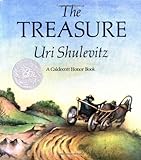Lessons & Units :: The Treasure 1st Grade Unit
Read-Aloud Lesson: The Treasure
Lesson Plan
The Treasure | 650L

- Learning Goal
- Explain how the journey of the main character illustrates the theme of the book.
- Duration
- Part 1: Approximately 20 minutesPart 2: Approximately 10-15 minutesPart 3: Approximately 10-15 minutes
- Necessary Materials
Provided:
Detailed lesson plan
Graphic organizer for guided practice
Independent student worksheetNot Provided:
The Treasure
-
This lesson is a close reading of the entire text. So it’s important to engage students often, to enhance their learning. Here are two tips:
- When you ask the more complex questions from the lesson, ask students to “turn-and-talk” or “buddy-talk” before answering.
-
Once you are deep into the lesson, instead of asking students every question provided, ask them to share with you what questions they should be asking themselves at that point in the text. This is also a great opportunity to use "turn-and-talk."
- Suggested teacher language is included in the lesson.
- We recommend you read the book once to your students, either the day or morning before teaching the lesson.
- This research-based, read-aloud lesson may seem long. Why do students need the lesson to be this way?
Part 1: Teacher Modeling and Questioning
Write the following student-friendly learning goal on the board, then read the learning goal out loud with the class:
We will see what we learn from reading about the journey the character takes.
Transition Students into the Text
Teacher says: Good things in life can be hard to get. Often we have to travel a long way to find something or achieve something of value. What was this man’s journey about? How did his journey turn out?
Read page 1 out loud, then stop. Page 1 ends with, “...his name was Isaac”.
1.
Teacher asks: The story begins by describing a character. What is the character’s name?
Students answer: The character’s name is Isaac.
Read page 2 out loud, then stop. Page 2 ends with, “...went to bed hungry”.
2.
Teacher says: We just read that Isaac lived in poverty. Even if I do not know what poverty means, I can try and figure it out from the rest of the sentence. “He lived in such poverty that again and again he went to bed hungry.”
3.
Teacher says (models thinking): If someone is going to bed hungry, again and again, I am going to conclude that that person doesn't have enough money to buy enough food to eat. And if he doesn't have enough money to buy food, then he is not going to have enough money for anything else. So when the author tells us that Isaac lived in such poverty that again and again he went to bed hungry, it means that Isaac was very poor and didn't have enough money for the basics, like food.
Part 2: Guided Practice and Discussion
For this oral lesson, it is suggested to have the completed graphic organizer on the board with the answers concealed. After students provide a correct answer, reveal the corresponding answer on the graphic organizer.
1.
Teacher says: We talked about the journey that Isaac went on to find treasure. Now we are going to look closely at each part of his journey.
2.
Teacher says: I will get us started. After Isaac sets out on his journey, the first places we read about him going are forests.
3.
Teacher asks: Where does Isaac go next?
Students answer: Isaac goes over mountains next.
4.
Teacher asks: Then Isaac reaches the capital city. Where does he go when he reaches the capital city?
Students answer: Isaac goes to the bridge by the Royal Palace.
Part 3: Student Independent Practice
Read each question out loud to your students and have each student complete the worksheet independently. For questions 5 A) and 6, you can have students draw their answers, answer orally, or write their answers depending on your students’ progress. If you have them write their answers, you may want to write the word(s) on the board for them to copy. Question 7 is a class discussion question.
Texts & Materials
Standards Alignment
(To see all of the ReadWorks lessons aligned to your standards, click here.)





Great close reading text.
This is a Great Read -Aloud Lesson that I look forward to utilizing in my classroom! This lesson is sure to teach students how to think, and understand what is being read to answer the comprehension questions.
Excellent comprehension lesson! I will definitely implement this plan in my next read-aloud and or whole-group student reading lessons